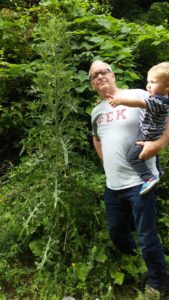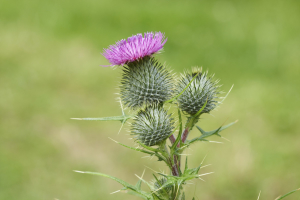

I got a phone call from a client that hired me to clear stones and plant some food plots on a hunt club property. He was mad…weeds had taken over the food plots. When I went to take a look, big nasty thistles were all over the place. There were three causes for this:
- first, the club for years had taken round bales up and left them in the winter to feed deer in the plots, never do that
- second, when I ran the rock rake I brought seed up from under the ground and exposed it to sunlight
- third, deer had eaten all the good stuff I planted and we had very little rain and poor soil (strip mined land)
What a mess. I had also added lots of liquid N to get things growing well and make a good impression. I sprayed and replanted the plots. They would have had a good stand of clover the next spring, but the club decided to kill my clover off and plant a “majic bean mix” which did nothing in spring. Oh well, that’s club mentality for you.
The lesson learned here is that when you till, you never know what will turn up in your plot. It may be wise to wait and see what is there in late June, then spray it if necessary and start over. Another thing I should have done was to plant a summer annual the first year to see what all would come in and then burn it all down with glyphosate and replant perennials in fall. That was a hard lesson. I lost a customer and looked foolish. But then, food plotting can make a fool out of anyone when you are just getting them started.
There are many native thistles to America like the one in the photo but the most common problem plants are the non-natives Bull and Canada. The main difference between the two is that Canadas have no spines on the stems and flowers while Bulls do. It is important to differentiate since they have different growth habits and require somewhat different control methods.
Canada thistle is a perennial as opposed to most other thistles which are biennial, with creeping roots that extend up to 17 feet horizontally and 20 feet deep. Plants grow 2 to 5 feet high. The stem is slightly hairy when young and grows hairier with age. Leaves are alternate and oblong. They have irregularly lobed margins with spiny crinkled edges terminating in a spine. The upper side of the leaf is dark green; the lower side is light green and slightly hairy. Some plants have leaves that are smooth on both sides. Canada thistle leaves are stalkless. The base of each leaf surrounds the stem, giving the impression that the stem is also spiny. (from: http://extension.psu.edu/pests/weeds/weed-id/canada-thistle) So you can imagine if you try to mow it – it will just multiple further. Its important to use a sytemic herbicide such as glyphosate or a right of way labeled Milestone. 2-4,D is recommended for thistle and is cheap and readily available. For really tough cases, use Persuit, which can be applied to soybeans, but its very expensive. It lasts in the soil all season to give longer effectiveness.
Another tactic is to till the field every time the small rosettes show up on the surface. Eventually, they will run out of energy and die. Then you can plant the field in the fall with a fast growing spring green-up plant, spot spray any survivors and you should have everything under control. Thistles are bi-annual, the first year they make that rosette that lies flat on the ground, looking pretty innocuous. The following year is when they get huge.
Bull thistle is the other very common non-native species that gives us headaches. It has a taproot and really nasty spikes on the end of each leaf. If you’re getting stabbed while walking through your field, that’s probably the brand you have. It’s very difficult to control. Use 2,4-D, Dicamba or Triclopyr.
